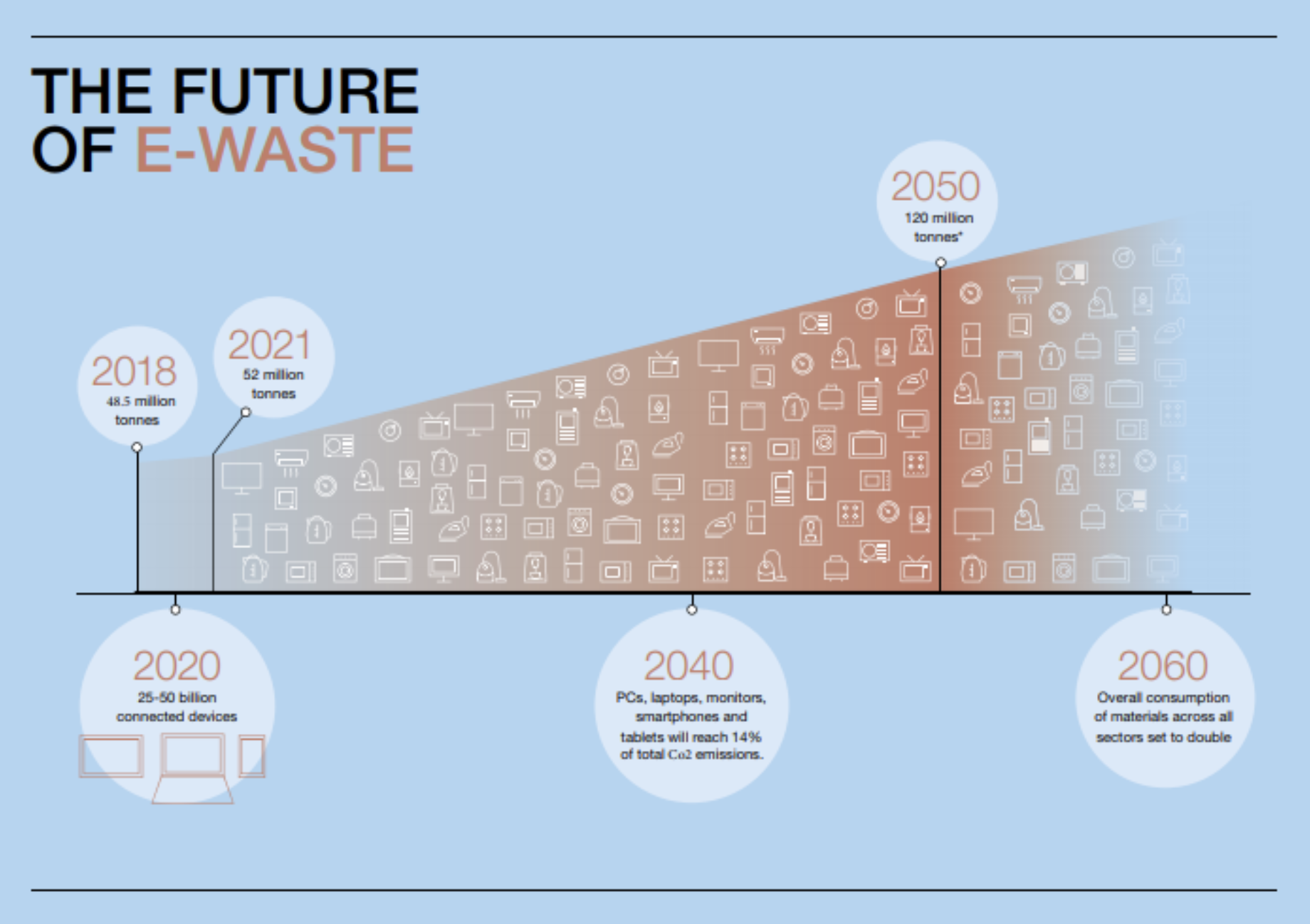Matthew Gault reports in Motherboard:
E-waste is now the fastest-growing waste stream in the world. This waste stream reached 48.5 million tons in 2018. E-waste typically isn’t biodegradable and contains components made from toxic materials. Breaking down and recycling the e-waste, causes health problems. “Workers...suffer high incidences of birth defects and infant mortality." The material value [of e-waste] alone is worth $62.5 billion, three times more than the annual output of the world’s silver mines and more than the GDP of most countries.
Electronic waste is a growing threat to the environment. Thanks to the low cost of manufacturing, it’s easier than ever for corporations to pump out millions of laptops, smart phones, internet of things devices, and other electronics. Electronics companies want consumers to keep buying new products, and believe repair and reuse hurts their bottom line. Old CRT monitors and televisions fill warehouses across the country, and companies like Apple and Microsoft pay lip service to the problem, but often pursue business practices that make the problem worse.
That’s led to a world where people throw away broken devices instead of repairing them, and those discarded iPhones, televisions, and laptops are poisoning the planet. A new initiative combining the efforts of the United Nations and the World Economic Forum and the World Business Council for Sustainable Development wants to change that.
The group formed the Platform for Accelerating the Circular Economy (PACE), and announced itself at Davos—a yearly gathering of the world’s wealthy elite—where it released its first report. “E-waste is now the fastest-growing waste stream in the world,” PACE’s report said. “It is estimated this waste stream reached 48.5 million tonnes in 2018.” Most of that waste comes from Europe and the United States and ends up in places like Nigeria and Hong Kong, which suffer the human and economic costs of disposing of the material.
E-waste typically isn’t biodegradable and often contains components made from toxic materials such as lead. Breaking down and recycling the e-waste, which can involve burn pits, causes health problems. “Workers...suffer high incidences of birth defects and infant mortality,” PACE wrote. “Toxic elements are found in the blood streams of informal workers at dumping grounds for e-waste where open burning is used to harvest metals.”
PACE wants to combat this growing problem by communicating the health dangers and economic cost of e-waste, building partnerships with corporations and governments, then enacting coordinated plans to tackle the problem. PACE thinks it can get corporations to act out of their self interest.
“The material value [of e-waste] alone is worth $62.5 billion, three times more than the annual output of the world’s silver mines and more than the GDP of most countries,” PACE’s report said.
Image: UN
“I think this report is really excellent, but I just want to be real about what it will take to shift our behaviors on this issue,” Nathan Proctor, head of consumer rights group US PIRG’s right to repair efforts, told Motherboard in an email. “Without public attention and engagement, it isn't enough to counter the entrenched system we have now, which thrives on disposable electronics. Hopefully we can help deliver that public pressure to help realize some of the goals of this paper.”
Proctor thinks the focus should be on people’s right to repair. “The obvious conclusion that our relationship with consumer electronics is out of whack,” Proctor said. “Repair is a critical part of fixing our relationship with these products, and is more efficient than recycling. People must be empowered to repair their own stuff. We have way too much waste in the world to only have the companies that manufacture products repair them. This has always been how devices were maintained until quite recently.”
The new UN coalition knows it has to get a lot of divergent interests, from corporations to governments to activists like Proctor, to act.. But the team is hopeful. “The UN E-waste coalition had a first extensive meeting with the big brands including Apple, Google and others, receiving their full support in establishing a closer cooperation on the e-waste topic,” Ruediger Kuehr—director of United Nations University’s Sustainable Cycles Programme—told Motherboard in an email. “It is clear to all that we will only be successful in channelling the issue towards more sustainable paths if we are successful in developing a closer cooperation.”
For Kuehr, just getting the elites at Davos to pay attention was a victory. “We succeeded in [getting] it on the political agenda and we are proud that it is now also a key-topic at the [World Economic Forum] Annual Meeting in Davos,” he said. Kuehr also pointed out that more and more consumers are purchasing products that generate e-waste and, if the problem isn’t handled, humans could be generating 120 million metrics tonnes of e-waste a year by 2050. According to PACE, making one tonne of laptops releases 10 tonnes of carbon dioxide into the air.
Kuehr thinks the biggest e-waste problem of the near future will be collecting all the garbage and sorting it properly for recycling. “Even in countries targeting a recycling rate of 85 percent—such as the [European Union]—only 30 to 40 percent are recycled at the moment,” he said. To increase those numbers, PACE plans to research reward systems to incentivize recycling. But Kuehr also puts the blame and responsibility at the feet of the electronics manufacturers. “[They need to] further support repair and refurbish to show the way ahead.”
Burning pits of toxic e-waste poisoning workers, and consumer goods smuggled into countries like Nigeria paint a dire picture. But there’s plenty of reasons to hope—the right to repair movement is growing in the US and Europe, and the UN’s new coalition represents a global approach to the problem.





















0 comments:
Post a Comment